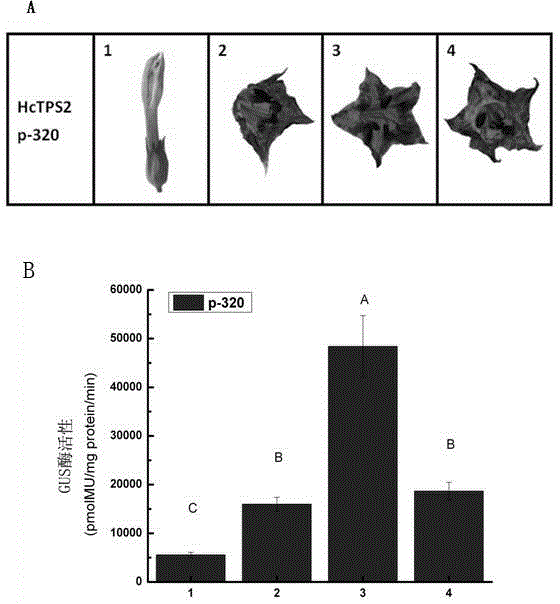Ginger flower floral specific and damage and pest induced TPS2 (Trehalose-6-Phosphate Synthase 2) promoter and application thereof
A promoter and specific technology, applied in the field of genetic engineering, can solve the problems of lack of space-time specificity, abnormal changes in plant physiology and morphology, affecting the normal growth and development of plants, etc., and achieve the effect of shortening the breeding time.
- Summary
- Abstract
- Description
- Claims
- Application Information
AI Technical Summary
Problems solved by technology
Method used
Image
Examples
Embodiment 1
[0036] Obtaining of TPS2 promoter sequence
[0037] S1. Extraction of total DNA from Gingerflower leaves: 0.1-0.2 g of Gingerflower plant leaf powder ground with liquid nitrogen was transferred to a 1.5 mL centrifuge tube. Add 1 mL of CTAB solution, bathe in water at 65°C for 30 minutes; invert once every 10 minutes. Then, add 1 mL of phenol:chloroform (1:1) to the centrifuge tube, invert several times, centrifuge at 10,000 rpm for 10 minutes, transfer the supernatant to a new centrifuge tube, add an equal volume of chloroform:isoamyl alcohol (24:1) , mix well, and centrifuge at 10,000 rpm for 10 minutes. Transfer the supernatant to a new centrifuge tube. Add an equal volume of isopropanol, mix upside down, centrifuge at 10,000rpm for 10 minutes, remove the supernatant, wash once with 70% ethanol, vacuum dry, dissolve in 30 μL sterile water, and use for PCR amplification. The composition of the CTAB solution is: Tris 100mM, NaCl 1.4M, 20mM EDTA, CTAB 2%, mercaptoethanol 0.1...
Embodiment 2
[0054] Fusion expression of TPS2 promoter and GUS to transform tobacco
[0055] S1. According to the sequence of the TPS2 promoter obtained in Example 1, primers for amplifying the three 5'-terminal deletion sequences p-320, p-780 and p-19283 containing HindIII and BamHI restriction sites were designed. The primer sequences are as follows:
[0056] Primers for amplifying p-320:
[0057] p-320-F: 5'-GGCCAAGCTTATACGTGCATGTTACAAGTATC-3' (SEQ ID NO: 14)
[0058] Primers for amplifying p-780:
[0059] p-780-F: 5'-GGCCAAGCTTCTGTTTCAAAACATCCAATTCCTC-3' (SEQ ID NO: 15)
[0060] Primers for amplifying p-1928
[0061] p-1928-F: 5'-GGCCAAGCTTACTGATAAGATAAGTTGC-3' (SEQ ID NO: 16)
[0062] Downstream primers are:
[0063] R: 5'-GGCGGATCCAATTTCAACTTCAAGTCCTGAC-3' (SEQ ID NO: 17)
[0064] S2. The pCAMBIA1300G plant expression vector was double-digested with HindⅢ and BamHI restriction endonucleases, and the large fragment was recovered on 1% agarose gel. Directly insert the target fr...
Embodiment 3
[0070] Transformation of Tobacco by Fusion Expression of TPS2 Promoter and Floral Aroma Gene HcTPS1
[0071] The HcTPS1 cloned recombinant plasmid was used as a template, and PCR amplification was carried out with specific primers introduced into SpeI and BamHI restriction sites. The PCR product was recovered with a TaKaRa recovery kit, and the recovered product was directly digested with SpeI and BamHI restriction endonucleases, and the target fragment was recovered on 1% agarose gel. The above constructed p-780 plant expression vector containing the HcTPS2 promoter was double-digested with SacI and BamHI restriction enzymes, and the large fragment was recovered from 1% agarose gel. The digested products were ligated and transformed into Escherichia coli DH5α. After enzyme digestion and sequencing identification, the recombinant plant expression vector is obtained. Agrobacterium tumefaciens EHA105 competent cells were prepared, and the above-mentioned recombinant plant expr...
PUM
 Login to View More
Login to View More Abstract
Description
Claims
Application Information
 Login to View More
Login to View More - R&D
- Intellectual Property
- Life Sciences
- Materials
- Tech Scout
- Unparalleled Data Quality
- Higher Quality Content
- 60% Fewer Hallucinations
Browse by: Latest US Patents, China's latest patents, Technical Efficacy Thesaurus, Application Domain, Technology Topic, Popular Technical Reports.
© 2025 PatSnap. All rights reserved.Legal|Privacy policy|Modern Slavery Act Transparency Statement|Sitemap|About US| Contact US: help@patsnap.com



